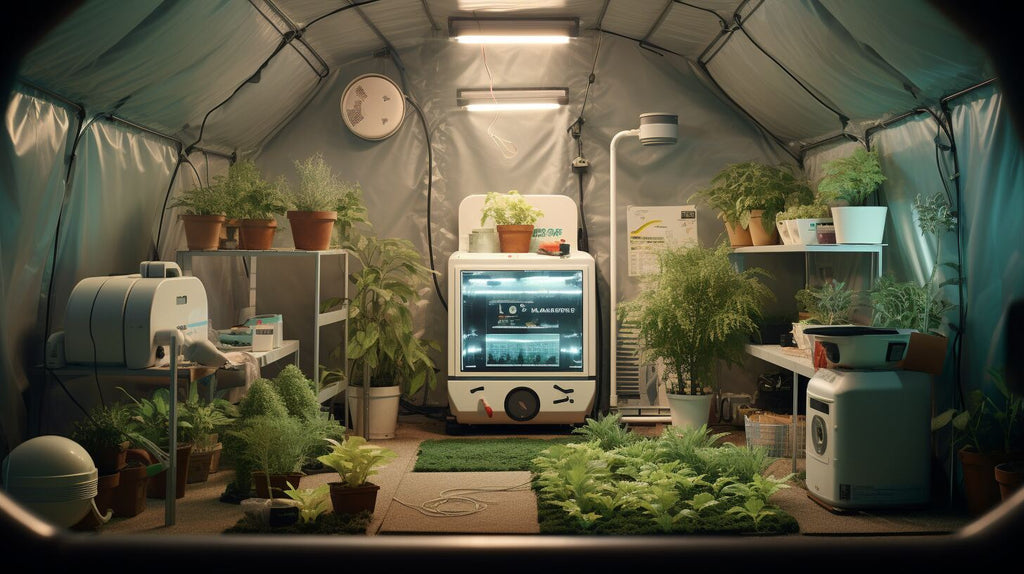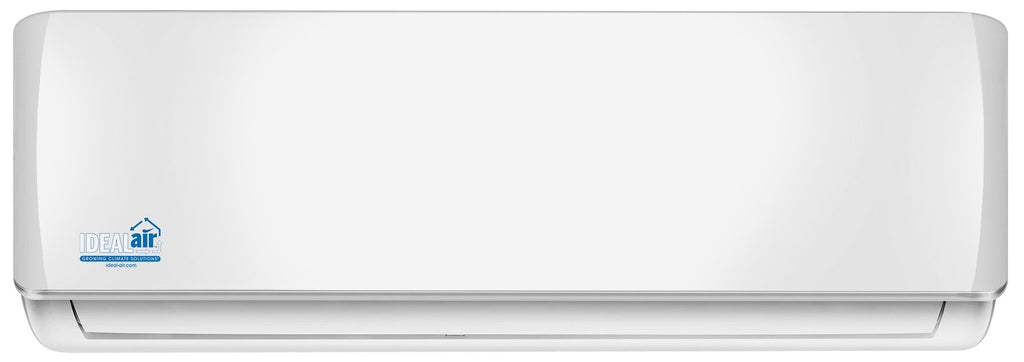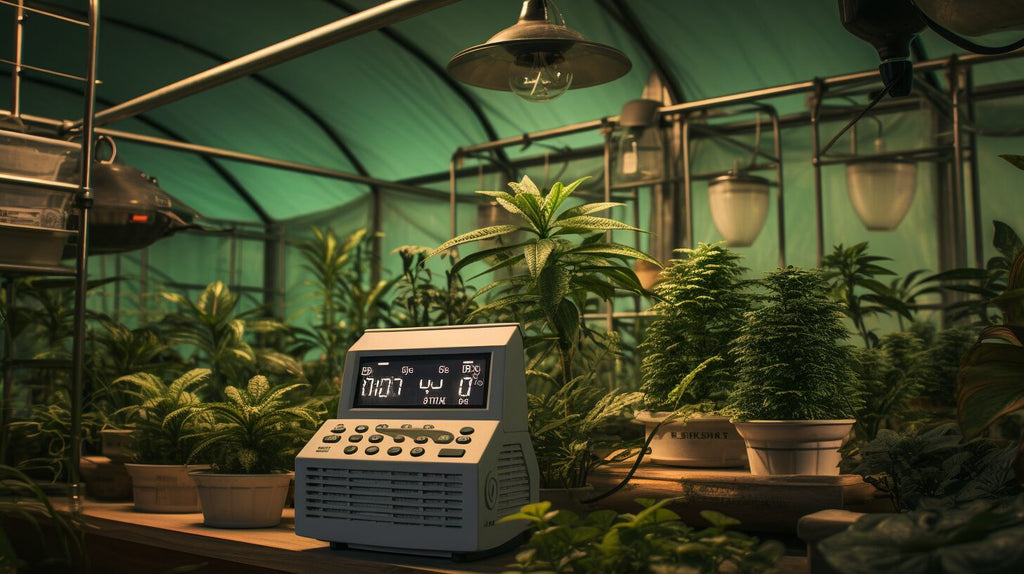How to Lower Humidity in Grow Tent?
We all know how important it is to keep the right humidity level in grow tents. Too much humidity can create a lot of problems, like mold or mildew, which are definitely not good for our plants. When the humidity in our grow tents gets too high, figuring out how to lower it can be tricky.
In this guide, we're going to look at some cool ways to keep the humidity level perfect for our plants, with or without using a dehumidifier. Let's dive in and find out how to keep our plant buddies happy and healthy!
Guide on How to Lower Humidity in Grow Tent

1. Boost Exhaust Rates
This is one of the most often suggested ways to reduce humidity in a grow tent. When comparing the humidity inside and outside of your tent, if the outside humidity level is less than the inside, you should raise the speed of the tent's exhaust fan to keep the air moving. Usually, fans with widths of 4′′, 6′′, or 8′′ are used for this.
You must increase air intake if your tent walls are constricting. Opening the tent flaps will let fresh air enter and exhaust air leave the top of the tent.
The bottom flaps must be sealed during blooming, which significantly lowers intake rates and is usually where growers run into problems.
Adjust the pressure with a fan controller to maintain a slight negative pressure within the tent. Choose short, straight duct lines for your tent exhaust to operate more effectively.
2. Get a Dehumidifier
The most apparent recommendation is this. A quality dehumidifier removes moisture from the air by sucking it up. You don't necessarily need to invest in a commercial dehumidifier, but depending on what kind of indoor grower you are, it might be a good fit to better control your grow tent's humidity and keep a balanced humidity level.
The "constant" option on our preferred dehumidifiers allows water to be continually drawn from the air and forced via a hose. That hose ought to go into a drain at the bottom. The only alternative if your dehumidifier doesn't have a continuous setting is to use the supplied water container.
Dehumidifiers should be installed outside your grow tent to provide a suitably conditioned "lung chamber" unless you're operating a sealed grow room. You will find this to be the best technique when decreasing the humidity in a grow tent. Replenishing damp tent air is relatively easy. You have to direct the dehumidifier's blower fan into the intake fan.
3. Get an Air Conditioner

Due to the relationship between temperature and humidity, installing an air conditioner to reduce the temperature within the grow tent will also reduce the excessive humidity.
The correct size of air conditioning equipment must be chosen, though. If the size is off, it won't be able to regulate the temperature, and if it's too large, condensation will result.
To ensure proper airflow, be sure to clean or replace the filter regularly, just like you would with your home air conditioner. A smaller air conditioner might not be able to effectively control the temperature in the space where you store your grow tent.
A grow tent's humidity levels may be reduced successfully with substantial air conditioners, but installing one that is too big can use too much power.
The proper air conditioner will continually replace heated air with cool air. All you have to do is routinely clean the filters to keep them from clogging, which can cause the airflow to be restricted and result in greater humidity.
4. Aeration
Allow air into your grow tent. High humidity may be lowered by allowing some air to blow some of the moisture in the air away.
Additionally, proper ventilation helps your plants produce excess moisture. Your tent can develop air holes. Holes big enough to let air through. Just be careful not to overdo it since too much aeration might result in extremely low humidity, making the plants pull water out of the soil.
Remember that opening your grow tent regularly might let smells into the space. Additionally, keeping your grow tent in a storeroom may expose the plants to rodent assaults.
5. Increased Ventilation
Enough ventilation must pass through the grow tent to function correctly. You can improve its performance if necessary by:
- Enlarging or adding new intake holes. The exhaust fan will become more operational this way.
- Instead of oscillating wall fans, use a few floor fans. To promote the best possible interchange of old and new air, floor fans draw air through the plant canopy.
- Invest in an atmospheric controller, which will aid the dehumidifier and regulate the intake fans' speed according to how humid or warm it is within the grow tent.
6. Lower Water Frequency
As already stated, plants lose most of the water they take in through their roots. The percentage can reach 95%. Therefore, plants will continue to absorb and evaporate water if you water them often. It will raise the humidity level by increasing the amount of water vapor in the surrounding air.
Additionally, if the soil has too much water, it evaporates and raises the humidity level. So, keeping the frequency of watering minimal is the ideal strategy. Plants should only be watered when required.
7. Do Not Overwater Plants
You could believe that overwatering the plants would make them grow more quickly, but doing so will just increase the humidity in the grow tent and lead to additional problems.
The amount of water that the soil can hold for the plants has a limit. Overwatering will cause extra water to collect in the plant trays, raising the humidity levels in the tent.
Overwatering is the practice of giving plants more water than they require. It pollutes the ecosystem with unneeded water. This probably makes the air more humid.
Give your plants the same quantity of water each time you water them, and be consistent with the timing of your watering to avoid overwatering. Additionally, it's ideal to just water plants when they actually require it. Before determining whether to water your plant or not, you may test the soil's moisture with your index finger.
The extra moisture is retained in the propagation trays and soil. After that, the air absorbs it, increasing the moisture content. When watering, exercise caution. Pour just enough water to support the growth of the specific plant. Various plants may require varying amounts of water.
7. Remove Any Pool of Stagnant Water in the Tent
Eliminating stagnant water in your tent is another way to control the excess humidity. Moreover, pools of excess water can create a fertile ground for bacterial growth as well as fungal growth, mildew growth, and mold growth, which will inevitably cause the humidity levels to increase dramatically.
These organisms can cause serious damage to plants by attacking the roots and leaves and can also produce harmful toxins that can be harmful to humans if inhaled. In addition, stagnant water can create a breeding ground for pests, such as mosquitoes, which can also be a risk to the plants.
To reduce the risk of stagnant water in a grow tent, it is important to ensure that the plants are watered properly and that the grow tent has good ventilation to help prevent excess moisture from accumulating. If you do notice that there is stagnant water in your grow tent, be sure to remove it as soon as possible to prevent any potential problems.
More: What Size Grow Tent Do You Need?
8. Be Wary of Unwanted Light
As your plants are in a tent, only use a trusted light source such as LED Grow Light. Light can have an indirect effect on the humidity in a grow tent and, therefore, on crop growth. During the day, when the lights are on, the light can create heat, which can increase the humidity inside the tent.
This is because warm air can hold more moisture, so when the air is heated, it can take in more moisture from the plants and soil, increasing the humidity in the tent. On the other hand, at night, when the lights are off and the temperature drops, the air will be able to hold less moisture, which can lead to a decrease in humidity.
However, it's important to note that the primary factor that determines humidity in a grow tent is the amount of moisture being added to the air. This can come from the plants themselves, as well as from other sources such as humidity control devices, watering practices, and the use of peat moss or coco coir as a growing medium.
What Are the Ideal Humidity Levels?

Spending weeks or months in a space heated artificially, whether from central heating or another source, is one of the significant challenges in maintaining plants inside. The good news is that we may avoid or treat humidity-related issues by understanding plant requirements and raising indoor plant humidity levels.
Humidity is measured by two methods: absolute humidity and the ratio of current to maximal absolute humidity, also known as relative humidity. You need to keep that in mind if you want to better control your grow tent humidity and keep it at an ideal level.
Relative humidity is a term used to describe how much water vapor is present in proportion to how many water particles are present in a given air volume. An ideal relative humidity acceptable for people, animals, and plants is determined.
So, what humidity level is ideal for plants? A humidity range of 60% to 70% is appropriate for most mature plants. Some tropical plants are used in conditions with 90% humidity. Cacti and other succulents only require 10% humidity. Generally speaking, plants with thicker leaves can withstand lower humidity levels.
These low percentages range from 80% to 90%. In a greenhouse or conservatory, plants, especially seedlings, can grow to over 80%, yet this is not feasible inside. This is great for some plants, particularly young plants or seedlings. However, it is not for humans.
- 60% - 80%: For practically all indoor plants, this range is appropriate. However, interior maintenance is challenging.
- 60% to 40%: During the summer, most houses' air humidity ranges between this range, which is ideal for most indoor plants. Some plants still require assistance, such as mist.
- 10% to 40%: Below 40%, the air becomes extremely dry, and these are likely the interior temperatures when central and artificial heating is employed. Succulents and cacti will thrive, but most plants will have leaf issues.
Getting a hygrometer to measure the humidity in the home is advised. A hygrometer monitors the temperature and humidity in a space, which is the best combination.
Why is High Humidity a Bad Idea in Grow Tents

Too little humidity in a growing environment can have various dangerous implications. However, having a rise in humidity is also undesirable. When your grow environment becomes excessively humid, the following fast effects and humidity issues may occur:
- Unwanted biological development, such as powdery mildew and bud molds.
- The bud rotting will not be observed until the harvesting stage appears. This is because there will be excessive moisture buildup.
- Reducing photosynthesis after decreasing the plant's capacity to take up CO2.
- A vapor-saturated atmosphere prevents plants' transpiration further. As a result, the pace of plant metabolism slows down.
- When a plant is young and fragile, it prefers humid air; as it ages, it prefers less humid air. Growing plants won't be able to develop quickly or have good health if the humidity level is kept high.
This is why it is important or vital to keep an ideal humidity range for indoor growing. Your grow room humidity has a direct impact on your plants and leaves, even if they are larger plants or baby plants. It's also a good rule of thumb to have specific levels of humidity depending on the stage of plant growth.
High Humidity Warning Signs
A hygrometer is ideal for evaluating the humidity levels within your grow room. You may periodically monitor the humidity levels by hanging the hygrometer above the plants in a well-ventilated location.
- Various indicators will let you know when to reduce the humidity in that grow tent:
- Leaves with white powdery mildew.
- Bud rot and mold.
- Due to heating up, leaves are developing poorly and are fading.
- Stunted blooming and growth.
Related: How To Raise Humidity in Grow Tent.
Why It's Important to Control the Temperature and Humidity
By regulating the temperature and humidity levels, you may give your plants the ideal environment from germination through growth phases and flowering or fruiting. For plant metabolism to rest, evenings need to be colder; a dip of around 10 degrees is preferred.
Plants continually take in water to absorb nutrients and develop to their maximum capacity. Controlling temperature and humidity levels allows you to manage the number of nutrients your plants consume. Both of these factors have an impact on how much water your plants absorb.
Read More: How To Clean A Grow Tent?
The Takeaway: Master Your Grow Tent Humidity!
We trust that these strategies will empower you to effectively manage and lower the humidity levels in your grow tent, creating the ideal environment for your plants to flourish. For those in search of high-quality, reliable grow tents designed with optimal humidity control in mind, look no further than Canada Grow Supplies. Our selection is tailored to support your plants' growth and ensure efficiency throughout their lifecycle.
Interested in expanding your indoor gardening knowledge, especially if you're just starting out? Dive into our comprehensive beginner's guide on how to set up a grow tent, where you'll find a treasure trove of information to get you started on the right foot.
Frequently Asked Questions
How do you get the moisture out of a grow tent?
To get the moisture out of a grow tent, you can use a dehumidifier to actively remove excess humidity or increase ventilation with an exhaust fan to let the moist air out. Additionally, placing moisture-absorbing products like silica gel packets inside the tent can help absorb dampness.
How do I keep the humidity up in my tent?
To keep the humidity up in your tent, you can use a humidifier to add moisture to the air or place open containers of water inside the tent, which will evaporate and increase humidity levels. Another method is to mist the plants lightly, but be careful not to overdo it to avoid mold growth.
How do you keep humidity low?
To keep humidity low, ensure good ventilation by using exhaust fans and opening vents to allow dry air to circulate and moist air to exit. Using a dehumidifier within the space can also effectively control and reduce excessive moisture levels.
How do you lower the humidity during flowering?
To lower the humidity during flowering, you can improve airflow within the tent by adding more fans and making sure your exhaust system is working efficiently to remove humid air. It's also beneficial to adjust your watering schedule, watering your plants less frequently to reduce excess moisture.
Last Updated: February 29th, 2024








